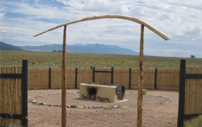In the U.S. today, choices for the contemporary-thinking after-death disposition consumer are mostly limited to cremation and green burial. At the same time, there are a few lesser-used disposition options available throughout the country, some which employ cutting-edge technology, and some which endow new life into age-old customs. From an open-air pyre in Colorado, burial-at-sea in New England, and even the burgeoning science of cryonics, there is a wide range of options for alternative disposition. And of course, contingent on state and local regulations and geographical considerations, you can choose from just about any of them.
Are there any options besides burial and cremation? What cutting-edge disposition options are available to me? Where can I find burial-at-sea options? What is promession? What is alkaline hydrolysis? What is Cryonics? What about open-air funeral pyres? How do you donate your body to science? How do I go about locating alternative disposition choices? SevenPonds provides an overview of the lesser-used disposition options available.
Things to Know:
- In Crestone, Colorado, a non-profit organization has established a permanent funeral pyre for “open-air cremations.”
- Several companies along our seaboards cater to those who wish for an environmentally friendly, full body burial-at-sea.
- In recent years, a growing number of entrepreneurs, businesses, and scientists are developing innovative ways to dispose of a person’s remains.
- Through creative use of new and established technology, promession, which is still in concept, and alkaline hydrolysis, which is currently only offered for human remains at one facility, may one day become common options beyond cremation and natural burial.
- With advances in nanotechnology, the future of cryonics as a viable life-prolonging option will become more certain.
- Donating your body to science can be a fulfilling, selfless gesture that will also eliminate your disposition costs. However, oftentimes you will not have any control over what happens to your remains once they have been signed over.
What about age-old disposition options available today?
Some consumers are choosing from options for disposition that have been in use for hundreds, even thousands of years, and remain widespread in many parts of the world:
- Funeral Pyres, or Open-Air Cremation: In Crestone, Colorado, the Crestone End of Life Project (CEOLP) has established a legal, permanent cement pyre from which to conduct “open-air cremations,” though the service is only available to residents of the community. This is the only funeral pyre in the country available to the public; some religious organizations also have pyres for use by their members. Participants have said that there is an undeniable splendor in witnessing an open-air cremation amidst the natural beauty of the Colorado Rockies, surrounded by loved ones and friends. SevenPonds has interviewed the founders, and written on the Crestone project. Though advocates of the process cite its environmental sustainability, in fact there are some concerns about the amount of CO2 burned in these open flames, including the metals and particulates vaporized during the process. According to Stephanie Gaines, CEOLP founder, the amount of particulate emission is minimal, and the Crestone pyre makes use of pine from beetle-kill trees, which helps to prevent future forest fires. The cremation takes about two hours, and uses only one fourth of a cord of wood.
- Full Body Burial-at-Sea: There are several companies along our coasts that offer environmentally friendly full body sea burial, where the body is either interred in a casket with holes drilled in the sides, or wrapped in a biodegradable shroud specially weighted to sink to the ocean floor. You can conduct full body burial-at-sea yourself, but you should take into account the paperwork that must be filed, the products that must be purchased (i.e., weighted shrouds — if you intend to use a casket you will have to bore holes into the sides yourself), and the very real safety concerns in piloting a vessel a significant distance from shore. The EPA regulates sea burial based on different geographical regions, and you will require a different set of paperwork based on where you conduct the burial. In California, for instance, you will need to file a permit with the EPA, and if more than one person is aboard the vessel, the pilot must be a licensed captain. If you intend to scatter ashes, you will also need a Declaration for Disposition of Cremated Remains. Typically, full body burial-at-sea must be conducted no less than three nautical miles from shore, and at depths of no less than 600 feet. Some people find this to be a graceful and majestic way to return their loved ones into the natural cycle of life.
Note: The US Navy also offers burial-at-sea to qualifying veterans or enlisted men and their relatives, though they employ metal caskets that are not biodegradable, and thus not environmentally friendly. Furthermore, the burial will be conducted while the ship is deployed, so the family is not allowed to be present. San Diego and Norfolk are the only ports of embarkation for intact remains.
What cutting-edge disposition options are available in the US?
There are two novel forms of disposition that are slowly beginning to reach the public, alkaline hydrolysis and promession, both of which apply long established technology towards the environmentally sound disposition of human remains. Then there is cryonics, whose many respected proponents hope to one day transform it into a truly viable option for addressing death and prolonging life.
- Alkaline Hydrolysis, also known as “resomation” or “bio-cremation,” has been in use for over 16 years by veterinary schools and two medical research facilities to dispose of animal remains and human remains that had been donated to scientific research. Through alkaline hydrolysis, the body is placed into a pressurized stainless steel chamber and immersed in a solution of 95% super heated water (350f) and 5% an alkaline solution of potassium hydroxide (KOH). The body is reduced to liquid and bone fragments, leaving any remaining metal prostheses to be recycled. The first facility catering to human remains opened in Ohio in early 2011, but was shut down in March when state officials said that they had not authorized such treatment of human remains. They also did not utilize the high-pressure, high temperature protocols as prescribed by the World Health Organization and the Centers for Disease Control, adding to the concern. Matthews Cremation, offering a high-pressure, high temperature system, has partnered with a well-established cremation facility in St. Petersburg, FL, and in late September of 2011 they began to offer alkaline hydrolysis to their customers.
- Promession is an intriguing form of disposition not yet available in the US, in which a body is frozen with liquid nitrogen and then broken down into fine, ash-like, compostable particles after being subjected to rapid vibrations. The particles are then filtered of any remaining solid parts that may have been within the body, such as mercury and metal from prosthetic limbs. The promession remains can then be interred underground where they are easily reabsorbed into the earth. As of today there are no promession provider facilities, or prematoria, but Promessa, the Swedish company developing the process, has secured licensing agreements in several countries, and has received a significant amount of praise for its environmental sustainability. No comprehensive studies have yet been conducted to assess its full environmental impact.
- Cryonics is the process, so often exploited by Hollywood filmmakers, of freezing and preserving a person’s body shortly after death, with the eventual goal of the body’s full restoration to the prime of life or better, following advances in medical science such as the advent of nanotechnology. Over its 30-plus years in practice, the science behind cryonics has continued to mature as its appeal has endured. Currently, there are about 250 cryogenically frozen individuals, and significantly more enrolled in preneed plans. While the scientific underpinnings of cryonics is strong, the proponents and developers themselves will be the first to admit that the procedure’s potential effectiveness remains theoretical. Still, in the coming century, many believe that breakthroughs such as the widespread use of nanotechnology are well within the realm of possibility. Today, cryonics is only legally employed after death, and as of yet no cryonics participant has been successfully revived from suspended animation. There are currently three facilities in the U.S., and one in Russia, that can sustain cryogenically frozen bodies. A sustained cryonics procedure is highly complex. You can find a summary of Alcor’s cryogenics procedures here. A cryogenics procedure can cost as little as $30,000 and as much as $200,000. You can refer to the Cryonics Institute, located in Clinton Township, MI, for the latest developments in this science and business.
Because they are both novel forms of body treatment, promession and alkaline hydrolysis have met with some legal and cultural resistance. Proponents say that promession and alkaline hydrolysis consume less energy than cremation and can more efficiently filter out harmful metals and substances, though there have been no comprehensive studies yet released to back up these statements. Thus far, the science, humaneness, and environmental impact of these alternative dispositions appear to be sound, and the financial burden comparable to typical cremation. For these reasons, SevenPonds is hopeful that funeral consumers in the U.S. will gain more access to these services in the coming years. As for cryonics, the only safe conclusion to be drawn thus far is that it’s too early to say. Though, of course, this should be no reason at all to deter the hopeful and enterprising individuals among us who wish to give it a try.
What about donating my body to science?
There are over 65 medical schools across the country that accept full body donation for research and education. There are also a number of for-profit companies that will facilitate a donation for the development of medical and surgical products. You can find a list of anatomical donation programs here. In return for your donation, many people will receive a sense of wellbeing and comfort, having contributed to a greater good. Full body donation also eliminates the cost of disposition for yourself and your family. This option is available to just about everyone, with stipulations that are largely based on state law. Some medical schools reserve the right to refuse donations in case of a body’s extreme obesity, emaciation, or death by infectious disease. The body of an organ or tissue donor most likely will not be accepted. After the medical school has finished using the body for research or educational purposes, the remains are cremated and usually scattered, for which you will receive written notification. These procedures vary greatly, and in some cases the cremation ashes will be returned to you or your service provider. Most likely, you will not have very much control over what happens to your loved one’s body following the donation. For more information, see our article on Donating Organs or Body. If you are interested in donating your body to science, contact a medical school near you well in advance in order to make arrangements.
For more information:
Promessa
http://www.promessa.se/?lang=en
Matthews Cremation
800-327-2831
http://www.matthewscremation.com/technology/bio-cremation.aspx
Crestone End of Life Project
719-588-7415
www.crestone-end-of-life.org
The Cryonics Institute
www.cryonics.org







